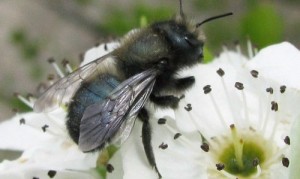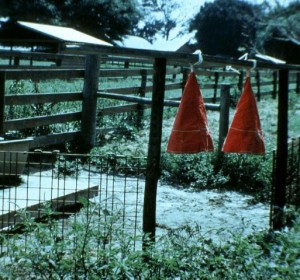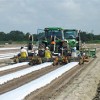
The University of Florida database of fact sheets called EDIS (Electronic Data Information Source) has many publications of interest to farmers and ranchers in Northwest Florida. http://edis.ifas.ufl.edu Each fact sheet has a PDF or printer friendly link in the top left corner. The following are just a few of the new fact sheets that have been recently added to the collection.
Beekeeping
Blue Orchard Bee, Osmia lignaria Say (Insecta: Hymenoptera: Megachilidae) (EENY549/IN982)

The blue orchard bee, Osmia lignaria Say, is a solitary mason bee native to the west coast of the United States and Canada. It is of great interest for use as a native pollinator of fruit trees and blueberries, and is easily managed due to its favorable biological characteristics. Blue orchard bees can be purchased online for pollination, and they are shipped as pupae ready to emerge in the spring. This 4-page fact sheet was written by Alden Estep, Catherine Zettel-Nalen, and James Ellis, and published by the UF Department of Entomology and Nematology, March 2013.
http://edis.ifas.ufl.edu/pdffiles/IN/IN98200.pdf
Beef Cattle
Effect of Age at Castration on Beef Calf Performance (AN289)
 A study in Florida was conducted to examine the issue of age at castration to determine if castration timing resulted in significant differences in growth rate and weaning weight in nursing calves. In addition, the study included a comparison between Angus and Brangus calves in the treatment groups to determine if there was a breed by castration effect. No differences in calf growth rates were observed in early compared to late castration. This 4-page fact sheet was written by Amie Imler, Todd Thrift, Matt Hersom, and Joel Yelich, and published by the UF Department of Animal Sciences, March 2013.
A study in Florida was conducted to examine the issue of age at castration to determine if castration timing resulted in significant differences in growth rate and weaning weight in nursing calves. In addition, the study included a comparison between Angus and Brangus calves in the treatment groups to determine if there was a breed by castration effect. No differences in calf growth rates were observed in early compared to late castration. This 4-page fact sheet was written by Amie Imler, Todd Thrift, Matt Hersom, and Joel Yelich, and published by the UF Department of Animal Sciences, March 2013.
http://edis.ifas.ufl.edu/pdffiles/AN/AN28900.pdf
Forced-Use Dust Bags for Management of External Parasites (ENY281/IG135)
 Dust bags are an effective method of horn fly and louse control. However, dust bags are only effective when hung in places where cattle are forced to use them. The best locations are areas where cattle must pass once or twice a day, or every other day, for instance between mineral boxes or water and pasture. During the field tests, forced-use dust bags provided an average of 90% horn fly control. Production was increased by an average of 34% over the normal management practice. This increase in production was equivalent to 1/3 lb/animal/day. This 5-page fact sheet was written by P. E. Kaufman and E. N. I. Weeks, and published by the UF Department of Entomology and Nematology, November 2012.
Dust bags are an effective method of horn fly and louse control. However, dust bags are only effective when hung in places where cattle are forced to use them. The best locations are areas where cattle must pass once or twice a day, or every other day, for instance between mineral boxes or water and pasture. During the field tests, forced-use dust bags provided an average of 90% horn fly control. Production was increased by an average of 34% over the normal management practice. This increase in production was equivalent to 1/3 lb/animal/day. This 5-page fact sheet was written by P. E. Kaufman and E. N. I. Weeks, and published by the UF Department of Entomology and Nematology, November 2012.
http://edis.ifas.ufl.edu/pdffiles/IG/IG13500.pdf
Vegetables
Insecticides Currently Used on Vegetables (ENY419/IG018)
This 12-page fact sheet lists many of the common insecticides currently labeled for use on vegetables in Florida. A number of new materials have been registered in the past few years or have had additional crops added to their labels. Some older organophosphate insecticides are now restricted to just a few crops, a result of recent rulings related to the Food Quality Protection Act. Changes continue, thus this listing may not be totally accurate at the time of printing. Written by S. E. Webb and P. A. Stansly, and published by the UF Department of Entomology and Nematology, August 2012.
http://edis.ifas.ufl.edu/pdffiles/IG/IG01800.pdf
Reducing Fumigant Application Rates and Soil Emissions with Plastic Mulch Technology (ENY046/IN403)
With the new fumigant regulations and rising cost of crop production, including fumigants, it would be desirable to reduce the standard
use rate of soil fumigants. The use of higher-barrier, gas-impermeable mulches may make it possible to reduce fumigant application rates by helping to contain the fumigant longer within the soil and reduce overall emissions into the atmosphere. The results of field studies show that fumigant application rates can be reduced by 20 to as much as 40% through the use of virtually impermeable or the more gas-tight TIF mulch films at the time of application. This 5-page fact sheet was written by J. W. Noling, and published by the UF Department of Entomology and Nematology, March 2013.
http://edis.ifas.ufl.edu/pdffiles/IN/IN40300.pdf
Fumigant Nematicides Registered for Vegetable Crop Use in Florida (ENY064/IN980)
This 3-page fact sheet lists of multispectrum fumigant nematicides currently registered for use on different Florida crops (Table 1); their maximum rates and specific details for field application (Table 2); and a generalized summary of maximum use rate and relative effectiveness of various soil fumigants for nematode, soilborne disease, and weed control in Florida (Table 3). Written by J. W. Noling, and published by the UF Department of Entomology and Nematology, January 2013.
http://edis.ifas.ufl.edu/pdffiles/IN/IN98000.pdf
 0
0

